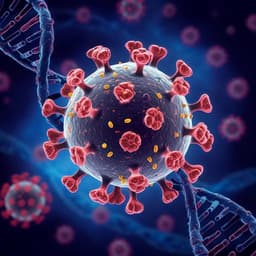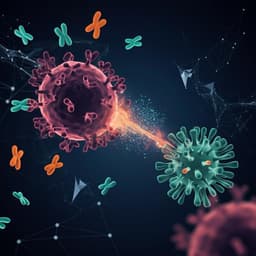
Earth Sciences
Calcium isotope ratios of malformed foraminifera reveal biocalcification stress preceded Oceanic Anoxic Event 2
G. D. Kitch, A. D. Jacobson, et al.
This groundbreaking study reveals how ocean acidification triggered biocalcification stress in planktic foraminifera during the Cretaceous Ocean Anoxic Event 2. Researchers from Northwestern University and the University of Urbino explore critical calcium isotope shifts and their implications for understanding past climate events and developing ocean alkalinity enhancement strategies.
Playback language: English
Introduction
Pelagic calcifiers, like foraminifera, pteropods, and coccolithophores, are crucial to the marine carbonate export to the seafloor, and their calcification rates are fundamentally linked to seawater carbonate chemistry. Large, rapid atmospheric CO2 increases cause ocean acidification (OA), decreasing seawater pH, carbonate ion concentrations, and saturation states while increasing total dissolved inorganic carbon. Studies of modern foraminifera show decreased biocalcification rates and shell thinning under OA. Reduced biocalcification buffers OA by increasing surface water alkalinity, similar to other negative feedback mechanisms, but it's geologically instantaneous. Increased surface ocean alkalinity enhances atmospheric CO2 drawdown, mitigating warming but compounding biocalcification stress. Understanding the calcification-CO2 relationship is key for quantifying the marine inorganic carbon pump and other global carbon cycle controls, including anthropogenic forcing, and directly relates to ocean alkalinity enhancement, a strategy for mitigating fossil fuel CO2 emissions and stabilizing ocean pH.
Geologic OA events offer insights into biocalcification responses to carbonate chemistry feedbacks during high CO2 periods. The Cretaceous was a hothouse period with high average atmospheric CO2, with intervals of significantly higher concentrations linked to massive volcanic eruptions. Cretaceous black shale deposits reflect short-term global carbon cycle perturbations and widespread oceanic anoxia within this high-CO2 climate. Eight oceanic anoxic events (OAEs) are marked by organic-rich deposits and large carbon isotope excursions (CIEs), along with geochemical evidence for large igneous province (LIP) emplacement. OAE2 (~94 Ma), defined by a 3–4% increase in organic carbon isotope values (δ13Corg), is linked to Caribbean and/or High Arctic LIP eruptions that drove transient atmospheric CO2 increases.
LIP-induced OA is implicated in faunal turnover and morphometric changes in foraminifera and coccolithophores associated with many OAEs. Interestingly, plankton turnover slightly precedes OAEs, along with size reductions in heavily calcified nannofossil taxa. For OAE2, nannofossil extinctions and placolith size reductions occur before the event, within the lower critical interval (LCI). Within the LCI, foraminifera show reduced test size, coiling direction reversals, and changes in chamber number and shape. These detailed morphometric changes offer an excellent opportunity to evaluate biocalcification stress. While test density and bulk density measured by micro-CT are optimal methods for examining OA-driven biocalcification stress in modern foraminifera, they are sensitive to dissolution and cannot be applied reliably to the geologic record. Therefore, high-precision calcium isotope (δ44/40Ca) measurements are used to study OA-biocalcification stress in deep time. Experiments show that slower precipitation rates yield higher δ44/40Ca values. Modeling studies show that rate-dependent shifts in ΔCaCO3–H2O correlate with carbonate system parameters. Geologic δ44/40Ca records from various archives show positive excursions consistent with reduced precipitation rates. This study utilizes the Ca isotope proxy to comprehensively test for biocalcification stress preceding OAE2.
Literature Review
Several studies have examined the impact of ocean acidification on marine organisms, particularly calcifying plankton. These studies, primarily using modern organisms and laboratory experiments, have shown a strong correlation between decreased ocean pH and reduced calcification rates, along with other physiological stress indicators like shell thinning. However, the long-term effects of ocean acidification over geological timescales, especially during events like OAEs, have been less well understood. The Cretaceous period, characterized by high atmospheric CO2 and the occurrence of OAEs, provides a natural laboratory for studying such events. Previous research on OAEs has focused on various geochemical proxies such as carbon isotopes, and the association between LIP eruptions and these events. However, the use of calcium isotopes as a proxy for biocalcification stress during OAEs is relatively recent and has yielded promising results. This study builds upon this existing body of work by using high-precision calcium isotope measurements in conjunction with morphometric data to investigate the onset of biocalcification stress before OAE2, providing a more detailed understanding of the interplay between ocean acidification and the dynamics of marine ecosystems during this significant geological event.
Methodology
This study generated paired high-resolution and high-precision δ44/40Ca, δ13C, and δ18O records for bulk carbonate and planktic foraminifera (Rotalipora cushmani) from the Bottaccione section in Gubbio, Italy, along with δ44/40Ca and δ13C records for bulk carbonate from the Aristocrat Angus (AA) core, Denver Basin, Colorado.
**Bulk carbonate sample collection and processing:** Scaglia Bianca Formation samples were collected from the Bottaccione section and the AA core. Samples were crushed, dissolved in 5% HNO3, filtered, and calcium concentrations determined using ICP-OES.
**Foraminiferal sample collection and processing:** Bulk rock from the Bottaccione section was treated with acetic acid, sieved, and dried. R. cushmani tests were picked, measured for Feret diameter, and sent to NU for isotopic analysis. Samples were cleaned with MilliQ water, dissolved in 5% HNO3, and calcium concentrations determined using ICP-MS. SEM imaging was used to confirm species identification and examine texture and authigenic precipitates.
**Calcium isotope ratios:** Calcium isotope ratios (44Ca/40Ca) were measured using a high-precision 43Ca-42Ca double-spike technique and a Thermo-Fisher Triton MC-TIMS. ASW standards and NIST SRM-915b standards were analyzed regularly. Sample and standard volumes were spiked, equilibrated, dried, and purified (bulk carbonates were processed through cation exchange columns, but foraminifera were not due to lower Ca concentration). Ca was converted to nitrate form, and ~10–16 µg of Ca was loaded onto Ta filament assemblies. Results are reported in δ-notation relative to ASW.
**Carbon and oxygen isotope analyses:** Carbon and oxygen isotope ratios were measured using a Thermo Scientific Delta V-Plus IRMS. Bulk sediments and foraminiferal samples were acidified and the resulting CO2 measured. Standards (CLMS and NBS18) were analyzed regularly.
**Statistical analyses:** Regression analysis was used for non-serially correlated data, and the R package Astrochron surrogateCor function was used for time-series data. Spearman's Rank Correlation was employed due to non-normality of datasets.
Key Findings
Both foraminiferal and bulk δ44/40Ca records from Gubbio, Italy, and the Western Interior Seaway (WIS) show coincident elevated values ~60 kyr prior to OAE2. A statistically significant correlation between δ44/40Ca and Os (a proxy for volcanism) indicates that the Ca isotope records reflect a reduction in ΔaCaCO3-H2O due to slower carbonate precipitation rates caused by OA. At the Bottaccione section, this coincides with morphometric indicators of biocalcification stress in foraminifera (test dwarfing and malformation). Bulk carbonate records capture the overall biocalcification response to OA, potentially including major assemblage reorganizations. The increase in both species-specific and bulk δ44/40Ca values before OAE2 suggests elevated CO2 and OA preceded the positive CIE. Elevated surface ocean alkalinity following reduced carbonate production enhanced atmospheric CO2 drawdown, sustaining biocalcification stress and creating a positive feedback loop for additional OA. The timing of elevated alkalinity and waning volcanic activity coincides with the Plenus Cold Event. The study highlights OAE2 as a geological analog for ocean alkalinity enhancement.
Discussion
The findings directly address the research question of whether biocalcification stress preceded OAE2. The statistically significant correlations between elevated δ44/40Ca values, morphometric abnormalities in foraminifera, and decreased Os isotopes strongly suggest that ocean acidification, driven by volcanic CO2 release, significantly impacted marine calcifiers well before the onset of OAE2, as traditionally defined by the carbon isotope excursion. The observation that surface ocean alkalinization followed the biocalcification crisis, leading to a potential drawdown of atmospheric CO2 and the Plenus Cold Event, highlights the complex feedback mechanisms within the carbon cycle. These results provide valuable insights into the dynamics of ocean acidification and biocalcification responses during major geological events and have implications for understanding the potential effectiveness of ocean alkalinity enhancement as a climate change mitigation strategy.
Conclusion
This study demonstrates that biocalcification stress, induced by ocean acidification from volcanic CO2 release, preceded OAE2 by approximately 60,000 years. The coincident increase in δ44/40Ca values in both foraminifera and bulk carbonate samples, along with morphometric evidence of stress in foraminifera, provides strong support for this conclusion. The subsequent decrease in δ44/40Ca values indicates ocean alkalinization, potentially explaining the Plenus Cold Event. This research underscores the importance of considering biocalcification feedbacks in climate models and has implications for ocean alkalinity enhancement strategies.
Limitations
While this study provides strong evidence for biocalcification stress preceding OAE2, it relies on a limited number of sites and species. Further research with a broader geographic and taxonomic scope is needed to confirm the generality of these findings. Additionally, the precise mechanisms linking LIP volcanism, CO2 release, and the specific species-level responses to ocean acidification require further investigation. The interpretation of bulk carbonate records could be influenced by the relative abundance of different calcifying species in the sediment.
Related Publications
Explore these studies to deepen your understanding of the subject.







